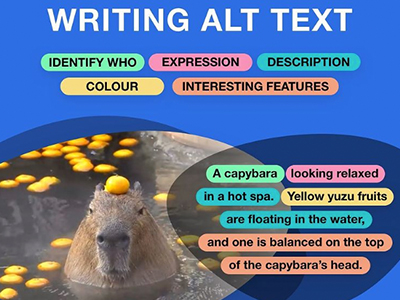Making your website and social media accessible to people with blindness and low vision.
Alt text and image descriptions are text-based descriptions of visual details in an image written primarily for people who are visually impaired (inclusive of blind/low vision). If an image fails to load on a website, alt text will be displayed in its place, and alt text is also used for search engine optimisation.
Image descriptions are similar to alt text descriptions that are used by screen readers to recognise images, though there are a few key differences between alt text and image descriptions:
Location
Alt text is typically attached to an image metadata or added in the “alt text” box on social media.
Image descriptions may be in the image caption.
Visibility
Alt text is usually only visible to screen readers, which read the alt text out loud or display it on a braille display. Image descriptions are “exposed” and can be read by anyone.
Alt text gives the user the most important information while image descriptions provide further detail. For example, alt text tells someone that there's a puddle on the floor, and image description tells someone that the puddle on the floor is in the middle of the floor and it's orange juice.
When writing alt text and image descriptions, imagine you are describing the picture to a friend over the phone and therefore they are unable to see what you are describing - what do they need to know to be able to picture the scene?
Visibility How it helps blind or low vision people
People who are blind or have low vision may use screen readers to access the internet or just have trouble distinguishing images. Screen readers will read out both the alt text and image descriptions, depending on what settings the user has enabled. Alt text and image descriptions can provide essential information such as text, links and image details.
Length of text
It is strongly recommended that alt text be 125 characters or less to ensure compatibility for popular screen readers. Image descriptions can be longer but I recommend keeping them the length of a tweet, or about 280 characters (around 50 to 60 words).
Use plain English - do not make your descriptions too flowery or poetic. Always check automatic alt text to make sure that the picture is what the automatic alt text says it is. Also, be aware that the automatic alt text on many websites will not correctly transcribe a New Zealand accent, so editing of the text will almost certainly be required.

What to describe
When composing image descriptions, it may seem difficult to decide what to include. Here are features that can be included in image descriptions - write about these when applicable:
· Placement of objects in image
· Image style (painting, graph)
· Colours
· Names of people
· Clothes (if they are an important detail)
· Animals
· Placement of text
· Emotions, such as smiling
· Surroundings
Visibility What not to describe
Likewise, there are some things that should be left out of image descriptions. These include:
· Descriptions of colours - no need to describe what red looks like
· Obvious details such as someone having two eyes, a nose, and a mouth
· Details that are not the focus of the picture
· Overly poetic or detailed descriptions
· Emojis
· Multiple punctuation marks






